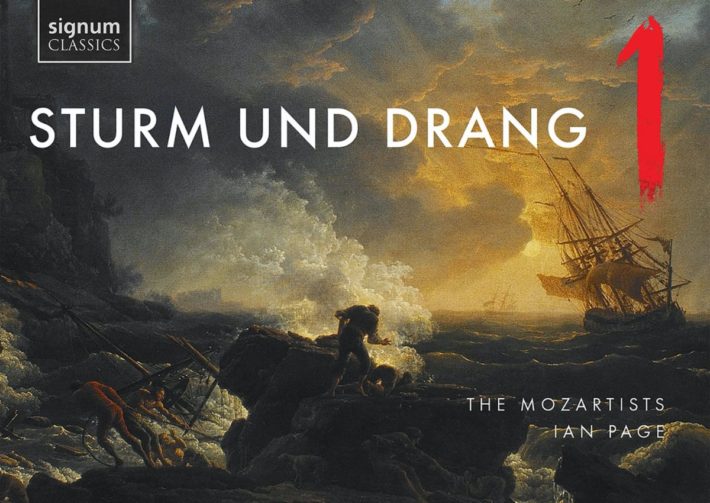Ian Page and the Mozartists’ latest album is the first in a series of seven that will cover music from the “Sturm und Drang” period, roughly 1760-1780. The main features are two very typically “stormy” symphonies, one by the neglected Franz Beck (1734-1809), the other by Joseph Haydn. These are supplemented by similarly distressed operatic numbers, with soprano Chiara Skerath singing the roles.
The three scenes that open the disc all successfully communicate something different about the Sturm und Drang period. Gluck’s final scene from “Don Juan” is a fitting opener; an ominous beginning eventually dissolves into chaos as Don Juan receives his punishment. The 35-member period instruments group “The Mozartists” capture the unsettled mood at the outset with unusually placid strings and winds, and a fine control which adds to the feeling of space in the underground cavern. Then the mounting diminished chords and descending string runs overtake any semblance of order, evoking a turmoil typical of Sturm und Drang. The Jomelli, which depicts a fallen Phaeton climbing back to heaven, is a calmer, almost peaceful number that shows its protagonist in a state of emotional fragility that captures a different side of the movement. Skerath is an apt Phaeton, determined and resilient, but there is also a note of plea in her tone, revealing the character’s inner fear. Haydn’s “Non v’è chi mi aiuta” from La canterina (track 3) is commedia dell’arte, or a parody of more serious operas, though, as the program notes point out, this aria sounds serious enough. Skerath could exaggerate her character’s plight a bit more; she can certainly pull off the heightened emotion, as she shows in the later Traetta, complete with two “unpitched screams” and full-throated distress.
The two symphonies are more of a mixed bag for the Mozartists. Beck’s Op. 3 G minor symphony is rarely performed, though it’s a vigorous, original work with plenty of good music. There are bright spots in the first movement, Page enjoying the music’s joyful miniature gestures, and the defiant, proud interruptions. One also hears, though, a rather un-nuanced approach towards phrasing; longer melodies lack direction, and the eighth-note-heavy passages that should be dramatic feel repetitive due to an overly mechanical rendering. The second movement is a worse offender, with no sense of dialogue between the melody and bass lines. The bass instruments don’t provide a strong enough metric pulse, and the melodies don’t receive enough phrasing. The upper strings use vibrato very sparingly – a little more warmth would go a long way. For a better version of these two movements, look to the Toronto Chamber Orchestra’s recording.
Related Classical Music Reviews
- Review: Haydn – Complete Symphonies, Vol. 8, “La Roxolana” – Antonini
- Review: Barbara Hannigan – “La Passione”
- Review: Beethoven – Symphony No. 6 (“Pastoral”) – Akademie für Alte Musik Berlin
Haydn’s symphony 49, “La Passione,” is a more well-known symphony that has been performed six ways from Sunday – two recent ones worth comparing are from Barbara Hannigan (reviewed here) and Giovanni Antonini, from his recent cycle of the complete Symphonies. To my ears, the Mozartists again suffer from under-developed phrasing and static bass lines. In the opening phrases of the first movement (an Adagio, unusually), the violins have no forward energy, nor do they find that introverted quality that sometimes generates wonderful, reverent expressivity – it’s just rather plain. Page continues to forgo vibrato throughout, and the resulting mezza di voce never feel convincing as expressive tools. Hannigan’s emotional performance may not be historically informed, but at least it stays true to the symphony’s subtitle. For bass line troubles, listen to the minuet and trio. The Mozartists can’t find any sort of elegance in the music; they aren’t playing the counterpoint between the melody and bass. Antonini’s ensemble is more attuned to this element of the music, and what emerges is a true set of dances. In the stormy second movement, the Mozartists do find some swagger, but again, they feel disconnected from the music. Listen to how radically the articulations in Hannigan’s ensemble changes as the music sways from loud to soft, from intense to calm. The Mozartists use a middling articulation throughout, not to mention small but persistent intonation issues, and as technically talented as they are, the music feels dull.
This album’s sound quality is crystal clear, both for the orchestra and Skerath, so anyone out for some classic Sturm und Drang opera can stop their search here: Page and the Mozartists have won lots of praise for their opera recordings, and rightly so. Their symphonic playing, on the other hand, is still developing.

“Sturm und Drang”, Vol. 1
Beck – Symphony in G minor, Op. 3, no. 3
Haydn – Symphony No. 49, ‘La Passione’
Scenes from works by Gluck, Jomelli, Traetta
Chiara Skerath – Soprano
The Mozartists
Ian Page – Conductor
Recommended Comparisons
Read more classical music reviews or visit The Classic Review Amazon store
Follow Us and Comment:
[wd_hustle id=”HustlePostEmbed” type=”embedded”]











